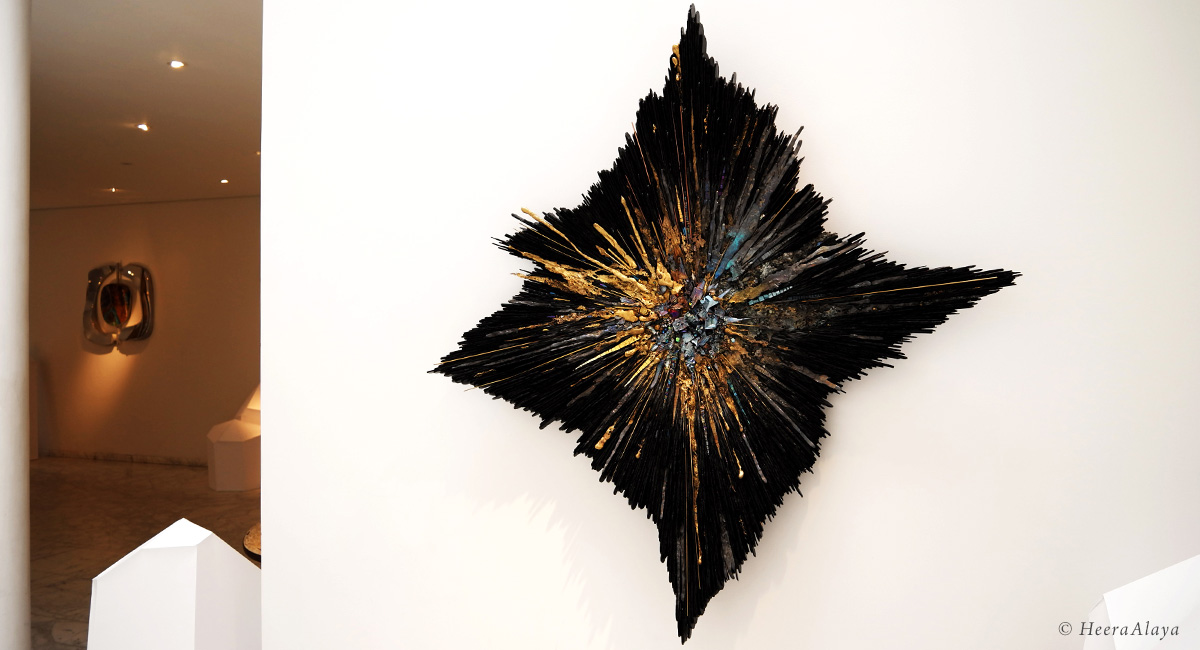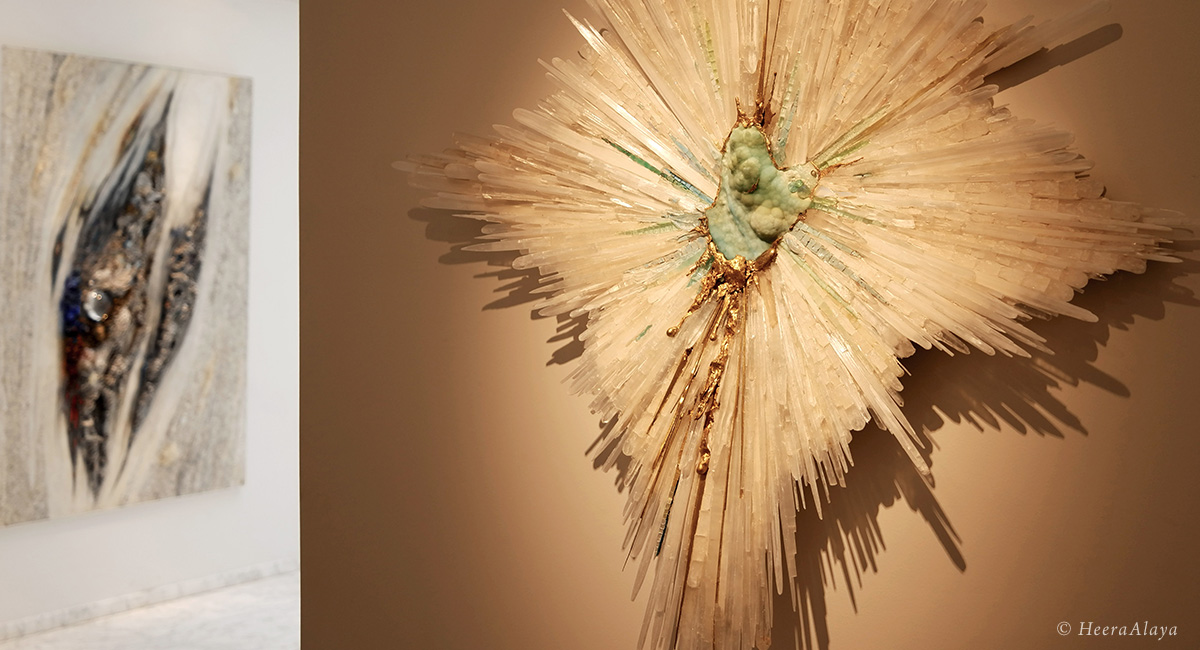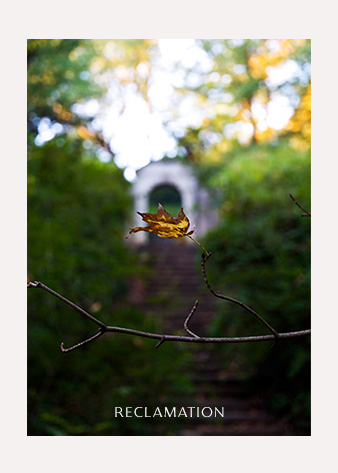
“I knew my art was right for me.
Creating a mosaic is my language;
it’s the only way to express myself.”
BEATRICE SERRE
Mosaicist, FR
September 10th, 2024
OPEN WINDOWS | In Conversation
Inspired by the cosmos, mosaicist Beatrice Serre revitalised age-old mosaic art with unique juxtapositions of shapes, textures, and colours while retaining ancient techniques. Serre’s innovative creations range from contemporary art to custom collaborations and installations for prominent brands—jewel-encrusted Cosmic clutches for Aquazzura to Art-Deco-inspired wall art for Cartier’s New York flagship store. Serre is the gold medal recipient of the 2018 Le Salon des Artistes Français [The French Artist’s Salon].
Heera Alaya: Beatrice, congratulations on 30 years of revolutionary creations. Before I proceed, I have to admire your attire, which appears to be in the continuity of your mosaics.
Beatrice Serre: Thank you. I am connected to my work. My silk kaftan is inspired by and in continuity with the minerals and ingredients of the exceptional mosaics. My work is like an auto portrait—but the auto portrait of everybody—because the colours and minerals are of nature, making it attractive and universal.
Correct me if I am wrong; is that a malachite you are wearing?
Yes, it is. I call this [Serre’s neckpiece] a cosmic jewel. Malachite is an incredible natural green mineral from Brazil, but it can also be turquoise, opal or a meteorite.
Is this cosmic jewel your creation?
Yes. It is from my inspiration. I have been making mineral mosaics for six years. It was initially for me, and now many people ask: “Beatrice, it is so different. How can I get one?”
Stéphane Rolland [French fashion designer] expressed interest in collaborating on his FW21 Couture collection, which is how I ventured into the world of fashion,
I also created a jewel-encrusted capsule collection of clutch bags and accessories, Cosmic, for Aquazzura (initially for the Biennale Di Venezia). We made 20 unique pieces, all of which sold in one hour.
What do you call your neckpiece?
In French, it is called a collier. It is handmade haute couture with my measurements. I wanted something exceptional to make the position of the neck queen-like.


Did your assimilated experiences during your formative years influence your interest in mosaics?
Yes. My environment was constantly changing in my childhood. I was inspired by everything I experienced, which naturally interested me in people and natural elements.
I have been fascinated by the cosmos and space since I was little. Initially, I practiced tapestry. Later, I studied space, mosaics, and art for seven years.
Years later, I learned the ancient Greco-Roman and Byzantine mosaic techniques. To achieve this result, you need to know how to use the tools, without which the mosaic is incomplete. I greatly respect the ancient tradition; we can have this incredible vibration today.
To me, mosaics symbolise resilience—when you cut and repair something, it is reborn. This gesture is the perfect way to achieve resilience and meditation.
Did anyone help you develop your style?
While I studied at ENSAAMA [École Nationale Supérieure des Arts Appliquées et des Métiers d’Art], my professor supported me as a student, encouraging me to explore infinite possibilities and freely develop mosaics. I incorporated materials like fossils, ceramics, and precious metals. And I created my first mosaic in marble and granite.
Often, a new concept is met with resistance. What was the reception to your bold pieces?
My mosaics were always a shock. People didn’t know why but were shocked: “What is it? What happened here? Is it ceramic? Is it mosaic? [Laughs] But I understand why; I made the contemporary mosaic.
How did you keep the faith to create something aligned with your passion?
I knew my art was right for me. Creating a mosaic is my language; it’s the only way to express myself. I don’t talk much, so the mosaic is the medium for my therapy.
I have a great respect for the antique mosaic. I can create an academic style because it is correct. Whenever I do my perception at home, I do twice the work. That is why I accept two propositions—two ways to do it.
The unexpected juxtapositions and paradoxical materials of each piece—including the furniture—make each one of your creations more fascinating than the other.
Thank you. My mosaics are irregular, and you can do anything—use the table with crystals in emergence. When I started thirty years ago, my mosaic was not for the masses. In Italy, for example, they said, “Beatrice, it is very nice, but it is not for now. It is not a traditional mosaic.”

Do you start with a prototype or a computer sketch? And do you allow yourself room to change the original design?
Never, never, never. When I create, I see the whole idea—it’s all done. I visualise the harmony and equilibrium between the pieces and elements.
I have Asperger’s Syndrome, and I think too fast. So, I can only work with myself. When I have an idea, it gives me ten or a hundred more ideas. I act quickly on what I need—for a designer, an architect, or myself.
I only make notes for big houses like Cartier or Dior—they need to see it. But my drawing is complete.
I work on several mosaics simultaneously, which is typical of my work. I start with the large piece and arrange the smaller pieces around it. And if something needs to be changed, I do that. Every piece eventually falls into place.
Do you improvise on your techniques?
I do [improvise]. Seeing my mosaic perfectly is one thing, but it is not what you imagine. It is good to have a new perspective. It is a good exercise to change one’s mind and improve oneself. It is like life—sometimes you must change your mind to improve. Seeing things from a different perspective and with different possibilities is a humble art.
Is there a focal point from where you begin?
Yes, of course. It [creating a mosaic] is like a painting. The architecture of a mosaic is complex. You put the most significant and essential pieces, then work around, putting little pieces. You try to find harmony. But in my case, I see the idea in my head. My hands are my mind; it is easy. It is like a flash photo forever but in 3D. It is a revolution.
Do you use specific adhesives for your mosaics?
Yes. I mount my tesserae [angular components] with laboratory-tested adhesives. These adhesives afford me elasticity and flexibility and allow my mosaics to withstand shock. Also, these glues enable me to create mosaics with no visible joints.
Do you have a favourite mineral?
Yes, Opal from Australia is my favourite mineral. It has all the colours of the universe, but the green and blue shine the most. It is like a constellation; it is incredible.
I also like turquoise. I also like the tiny ones, like the ordinary ones under your shoes. So I like what is not nice too. I like the sublime, something that nobody looks at.
For me, it is an emotion. It is not only a giant crystal shining; everybody can do that. A mineral shinning is lovely by itself. But I try to find harmony between different elements. Not only minerals, but you also have some oxidised metals and some wood.


Is there a specific stone or mineral that is difficult to work with?
Green marble and granite are very tough. But mosaic is an art you deserve because you use nature, respect it, and be a student of nature. The minerals, the marble, the stones, even the glass that I use,
From where do you source your materials?
I collect materials from all over the world and in different ways. I collect myself when I travel and have some excellent sellers and friends. I have known them for years; they know my choices and preferences. But I am open to new ways to procure materials from all over the world.
Describe your atelier [studio] and the ambient sound.
My quiet atelier is flooded with natural light and filled with tools and an assortment of materials—from granite to stone and fossils and from crystal to marble to enamel. I have a telescope to observe the cosmos. Here, I channel my emotions, and I am immersed in creating one-of-a-kind pieces that delight me with textures and colours. Each tessera [fragment] has its place in the mosaic, like the human mosaic.
I am surrounded by nature and have many animals and birds. I like to listen to diverse music depending on my feelings and the theme I am working on. Sometimes, I need it to be meditative, and at other times, very energetic.
Do you have plenty of tools?
Not that much. I only use a few. Look at my hands [Beatrice laughs, extending her hands]. I use my hands much more because I have the contact to feel the very fine, the tiny matters.
Like a potter or surgeon?
Absolutely. You can have very big, heavy, and tiny light pieces; all are in fusion.
What does the process of creating do for you?
The mosaics I design enable me to venture into different realms—geology, mineralogy, and astronomy, which is my passion.
Everything interests me; it can be a sound, a colour, music, or an idea. Or it can be a beautiful mineral talking to me. I see an element, and it inspires me. And I see how I can use it—the position, is it for furniture, a table, a sculpture or a decorative panel? So I keep it [ideas] in my studio, and I can use it very quickly or after years have passed, I have the idea to take it because it was the perfect element for an important idea.

Do you take a break when you are creating?
[Laughs] No, I am always working. It’s hard for me not to create. I hardly ever take holidays; I don’t know Sunday. I have slept four to five hours a night since I was little.
What is your state of mind while creating mosaics—are you calm, anxious or excited?
I am always calm.
Once, I was teaching in Italy, and everyone was stressed, anxious, and losing control. The students didn’t know what happened. Minerals have a vibration. As they were glueing and placing each piece, making their mosaic, they were rebuilding inside themselves. The mosaic goes very, very deep inside us.
Do you have interests outside of mosaic?
When I have time, I go into forests, look at animals, do sports, run for my mind and health, and do yoga for the mind.
Does the process of creating for yourself versus a commissioned mosaic differ?
I am like a child dreaming, and I do the same, whether it is for collaboration or myself. I am open, so I make my frequency the same as the frequency of the person. And I project it on the person and work precisely adapted for that person.
Do you have a preference for the scale of the mosaics you create?
I prefer creating vast pieces, monumental sculptures for entrances, majestic hotels and gardens.
What role does installation play in a gallery?
Along with the suitable showing space, the installation plays a crucial part. Some people find mosaics mysterious, as they think of the antique way [of mosaic art]. So it is essential to have a distance between pieces—to move from energetic to soothing, reading my mosaic in different degrees—simple to complex.
When you enter, you can read symbols, which are part of science. It is not for everybody—the more you have an approach, the more you can see and understand.

What are your thoughts on your sell-out creations for Aquazzura, your installation at Cartier, and Galerie Gastou’s [Paris] celebration of your decades of bold creativity?
I am happy for the world of contemporary mosaics. Being well-received is good for me and the art of mosaic. I immediately think, “There is an open door now. I was working all my life.”
When I see this, I think about all the mosaics. Something is changing, and it is best for everybody. It is a revolution; it means it is accepted.
What have you learnt through the process of creating mosaics? And what do you hope your mosaics will offer the world?
I have been a mosaic artist for thirty years, during which time I have taught and exhibited my creations. While exploration has introduced me to new terrains, mosaic has shown me that harmony and unity for everyone lie in its reconstruction and rebirth.
People suffer so much because they don’t know they are at war with themselves, and they must liberate themselves and accept their situation to have freedom. We don’t know life—what happened when they were children. I don’t judge anybody; I want my mosaics to symbolise repair, dreams, and pleasure.
The mosaic is a language of the hand and mind, directly connecting with nature.
Learn more about Beatrice Serre.




